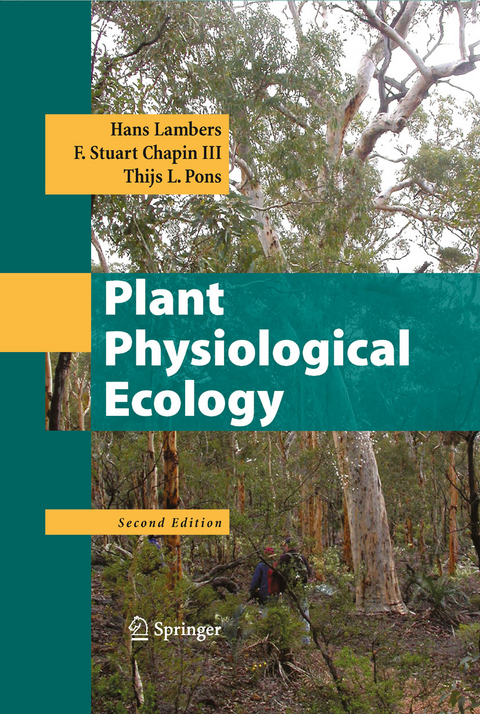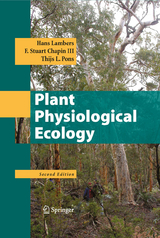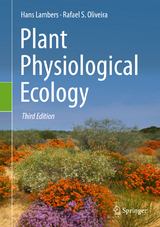Plant Physiological Ecology
Springer-Verlag New York Inc.
978-0-387-78340-6 (ISBN)
- Titel erscheint in neuer Auflage
- Artikel merken
Hans Lambers is Professor of Plant Ecology and Head of School of Plant Biology, Faculty of Natural and Agricultural Sciences at the University of Western Australia. F. Stuart Chapin III is Professor of Ecology at the Institute of Arctic Biology, University of Alaska Fairbanks. Thijs L. Pons recently retired as Senior Lecturer in Plant Ecophysiology at the Institute of Environmental Biology, Utrecht University.
Contents Foreword (by David T. Clarkson) About the authors Foreword to the first edition by David T. Clarkson) Acknowledgments Abbreviations 1. ASSUMPTIONS AND APPROACHES Introduction—History, Assumptions, and Approaches 1 What is Ecophysiology? 2 The Roots of Ecophysiology 3 Physiological Ecology and the Distribution of Organisms 4 Time Scale of Plant Responses to Environment 5 Conceptual and Experimental Approaches 6 New Directions in Ecophysiology 7 The Structure of the Book References 2. PHOTOSYNTHESIS, RESPIRATION, AND LONG-DISTANCE TRANSPORT 2A. PHOTOSYNTHESIS 1 Introduction 2 General Characteristics of the Photosynthetic Apparatus 2.1 The 'Light' and 'Dark' Reactions of Photosynthesis 2.1.1 Absorption of Photons 2.1.2 Fate of the Excited Chlorophyll 2.1.3 Membrane-bound Photosynthetic Electron Transport and Bioenergetics 2.1.4 Photosynthetic Carbon Reduction 2.1.5 Oxygenation and Photorespiration 2.2 Supply and Demand of CO2 in the Photosynthetic Process 2.2.1 The CO2-response Curve 2.2.2 Supply of CO2 - Stomatal and Boundary layer Conductances 2.2.3 The Internal Conductance 3 Response of Photosynthesis to Light 3.1 Characterization of the Light Climate under a Leaf Canopy 3.2 Physiological, Biochemical, and Anatomical Differences between Sun and Shade Leaves 3.2.1 The Light-response Curve of Sun and Shade Leaves 3.2.2 Anatomy and Ultrastructure of Sun and Shade Leaves 3.2.3 Biochemical Differences between Shade and Sun Leaves 3.2.4 The Light-response Curve of Sun and Shade Leaves Revisited 3.2.5 The Environmental signal for Shade Acclimation inChloroplasts 3.3 Effects of Excess Irradiance 3.3.1 Photoinhibition - Protection by Carotenoids of the Xanthophyll Cycle 3.3.2 Chloroplast Movement in Response to Changes in Irradiance 3.4 Responses to Variable Irradiance 3.4.1 Photosynthetic Induction 3.4.2 Light Activation of Rubisco 3.4.3 Post-illumination CO2 Assimilation and Sunfleck Utilization Efficiency 3.4.4 Metabolite Pools in Sun and Shade Leaves 3.4.5 Net Effect of Sunflecks on Carbon Gain and Growth 4 Partitioning of the Products of Photosynthesis and Regulation by 'feedback' 4.1 Partitioning within the Cell 4.2 Regulation of the Rate of Photosynthesis by feedback 4.3 Sugar-induced Repression of Genes Encoding for Calvin-cycle Enzymes 4.4 Ecological impacts Mediated by source-sink Interactions 5 Responses to Availability of Water 5.1 Regulation of Stomatal Opening 5.2 The A-Ci Curve as Affected by Water Stress 5.3 Carbon isotope Discrimination in Relation to Water-use Efficiency 5.4 Other sources of Variation in Carbon isotope ratios in C3 Plants 6 Effects of Nutrient Supply on Photosynthesis 6.1 The Photosynthesis-nitrogen Relationship 6.2 Interactions of Nitrogen, Light and Water 6.3 Photosynthesis, Nitrogen, and Leaf Life-span 7 Photosynthesis and Leaf Temperature: Effects and Adaptations 7.1 Effects of High Temperatures on Photosynthesis 7.2 Effects of Low Temperatures on Photosynthesis 8 Effects of Air Pollutants on Photosynthesis 9 C4 Plants 9.1 Introduction 9.2 Biochemical and Anatomical Aspects 9.3 Physiology of C4 Photosynthesis 9.4 Intercellular and Intracellular Transport of Metabolites of the C4 Pathway 9.5 Photosynthetic Nitrogen-use Efficiency, Water-use Efficienc
| Erscheint lt. Verlag | 24.10.2008 |
|---|---|
| Zusatzinfo | 106 Tables, black and white; XXIX, 605 p. |
| Verlagsort | New York, NY |
| Sprache | englisch |
| Maße | 178 x 254 mm |
| Gewicht | 1840 g |
| Themenwelt | Naturwissenschaften ► Biologie ► Botanik |
| Naturwissenschaften ► Biologie ► Genetik / Molekularbiologie | |
| Naturwissenschaften ► Biologie ► Ökologie / Naturschutz | |
| ISBN-10 | 0-387-78340-7 / 0387783407 |
| ISBN-13 | 978-0-387-78340-6 / 9780387783406 |
| Zustand | Neuware |
| Informationen gemäß Produktsicherheitsverordnung (GPSR) | |
| Haben Sie eine Frage zum Produkt? |
aus dem Bereich





